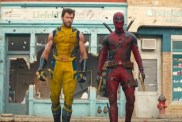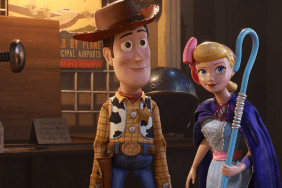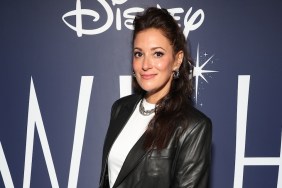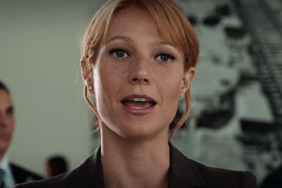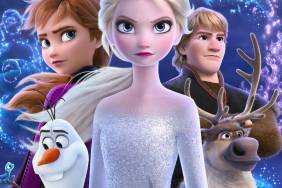
Explore the sights and sounds of Disney’s Mammal Metropolis, right here in our Zootopia Guide
“People have done animals in the animal world,” says Zootopia director Byron Howard. “Like ‘Lion King’ or ‘Ice Age.’ They’ve done animals in the human world. ‘Jungle Book,’ ‘Madagascar.’ Those types of movies. But we’ve really never seen animals in the modern world, where humans never existed. That was the twist that got John [Lasseter] very excited.”
Howard, who co-directs the Walt Disney Animation feature with Rich Moore and Jared Bush, previously spoke with ComingSoon.net about crafting the wild world of Disney’s latest. In this, our Zootopia guide, we’re going behind the scenes of the March 4 release and exploring the incredibly-detailed and pun-riddled world of the animated “Mammal Metropolis.”

Zootopia Guide: Mammals Only!
When you think of all the animal designs we’ve seen so far in the Zootopia trailers, it’s easy to have completely missed the fact that the film deals entirely with mammals. You won’t find any birds, reptiles, insect or sea life in Zootopia. That’s a decision that was made to highlight Zootopia‘s central theme.
“It’s a mammal metropolis,” Howard explains, “because the film is about predators and prey. After a lot of research, we found that the predator and prey divide was the widest in the mammal world.”
That’s one of the reasons that it makes sense for Zootopia‘s story to follow two animals facing opposite directions on the food chain. Ginnifer Goodwin voices Officer Judy Hopps, an optimistic young rabbit from the Bunnyburrow countryside who has come to the big city to prove her worth. It’s there that she meets Nick Wilde (Jason Bateman), a sly confox who tries to take advantage of Hopps’ good hearted naïveté.

Zootopia Guide: A Different Point of View
Even as the elaborate Zootopia city and culture grew around the still-developing Hopps and Wilde characters, the filmmakers came to the decision that the story wasn’t living up to its potential. Although Wilde had initially been conceived of as the film’s protagonist, the story was reimagined so that audiences could visit Zootopia through Hopps’ eyes.
“She’s a starry-eyed country girl,” says Howard, “coming in with all these ideas about how she’s going to make a difference.”
One of the obstacles that Hopps has to overcome is the stereotype that bunnies aren’t as capable of serving in law enforcement as some of Zootopia‘s larger species. She’s going out of her way to dismiss all stereotypes, which is part of why she’s initially fooled by Wilde. She doesn’t believe the stereotype that all foxes are sly and mischievous. By playing with animal stereotypes, the filmmakers are able to take on an important issue on a strictly allegorical level.
Zootopia Guide: The Big Six

Zootopia was conceived of as a city from the ground up. At its center is Sahara Square. Once, long ago, it was a watering hole and, like actual cities, the design grew outward from that central location.
“What we wanted for this city to look like it’s been lived in,” explains Art Director of Environments Mathais Lechner of where audiences are catching up with Zootopia’s long fictional history. “It has garbage lying around. It has streets, trees and buildings of different kinds and architectures. All the details that a real city entails.”
Envisioning the way Zootopia functions as a city meant imaging the ways different types of species would spread out into their own five areas. In Zootopia, they’re known as Tundratown, The Rain Forest District, Bunnyburrow, Savanna Central and Little Rodentia.
“What feels different about how Chinatown borders Little Italy?” Howard says of the research that went into getting Zootopia‘s layout just right. “How do the Bronx, Queens and Brooklyn all interact?”
Zootopia Guide: A City of the World

It was important for the Zootopia team to keep the film function on an international scale. Even though elements of several US cities were examined for Zootopia‘s ultimate design, they scoured the world looking to incorporate city design that meshed with animal patterns. The zebra crossings in Zootopia are one obvious example, but eagle-eyed moviegoers will appreciate how every element of life in Zootopia is envisioned as something that would have actually been built for a specific purpose by animals.
“We asked, ‘How do you put a tundra and a desert next to each other?” says production designer David Goetz. “Well, the answer is rather simple. You build a massive air conditioning wall that separates the two environments. Just like our own air conditioners, one side blows out cold air, cooling Tundratown, while the other side blows out hot air to heat Sahara Square.”
Zootopia Guide: A Matter of Scale

One of Zootopia‘s tricky elements was the decision to keep all of the animals their actual relative sizes. That means that certain parts of the city are designed to accommodate animals ranging from mice to elephants. That means that certain species have equal access in civic areas, (extending to the subway systems), while other areas may tend to be more or less off limits.
There’s one unique sequence in Zootopia that has a lot of fun with the audience’s sense of scale. A chase scene, at one point, has Judy Hopps crossing the border into Little Rodentia. A town built for mice, Little Rodentia lets Hopps suddenly become a relative giant and the chase to continue like a Kaiju showdown.
Zootopia: What it All Means

As much as Zootopia‘s story looks to explore some pretty relevant societal issues, it’s meant to play first and fur-most as a family adventure.
“We never want to preach in any of our entertainment,” says Rich Moore. “What we like to do is take an issue and examine it… What I would take away from this film, if there’s a message or a theme to it, it’s that you define you. The world has an opinion about who you are, but you ultimately define yourself.”
Also featuring the voices of J.K. Simmons, Idris Elba, Alan Tudyk, Tommy Chong, Octavia Spencer, Bonnie Hunt, Jenny Slate, Tommy ‘Tiny’ Lister, Don Lake and Raymond Persi, Zootopia arrives in theaters March 4.
Zootopia
-
Zootopia

ZOOTOPIA – Pictured (L-R): Judy Hopps, Nick Wilde. ©2016 Disney. All Rights Reserved.
-
Zootopia

ZOOTOPIA – Pictured: Judy Hopps. ©2016 Disney. All Rights Reserved.
-
Zootopia

ZOOTOPIA – Pictured (L-R): Judy, Bonnie, and Stu Hopps. ©2016 Disney. All Rights Reserved.
-
Zootopia

ZOOTOPIA – RAINFOREST DISTRICT. ©2016 Disney. All Rights Reserved.
-
Zootopia

ZOOTOPIA – Pictured (L-R): Judy Hopps, Nick Wilde. ©2016 Disney. All Rights Reserved.
-
Zootopia

ZOOTOPIA – TRAIN STATION. ©2016 Disney. All Rights Reserved.
-
Zootopia

ZOOTOPIA – Pictured (L-R): Nick Wilde, Judy Hopps, Mr. Big. ©2016 Disney. All Rights Reserved.
-
Zootopia

ZOOTOPIA – Pictured (L-R): Judy Hopps & Clawhauser. ©2016 Disney. All Rights Reserved.
-
Zootopia

ZOOTOPIA – Pictured (L-R): Assistant Mayor Bellwether & Mrs. Otterton. ©2016 Disney. All Rights Reserved.
-
Zootopia

ZOOTOPIA – Pictured (L-R): Nick Wilde, Judy Hopps, Mr. Big. ©2016 Disney. All Rights Reserved.
-
Zootopia

ZOOTOPIA – Pictured (L-R) Mayor Lionheart, Assistant Mayor Bellwether. ©2016 Disney. All Rights Reserved.
-
Zootopia

ZOOTOPIA – Pictured: Judy Hopps. ©2016 Disney. All Rights Reserved.
-
Zootopia

ZOOTOPIA – Pictured (L-R): Nick Wilde, Judy Hopps. ©2016 Disney. All Rights Reserved.
-
Zootopia

ZOOTOPIA – Pictured (L-R): Chief Bogo, Judy Hopps. ©2016 Disney. All Rights Reserved.
-
Zootopia

ZOOTOPIA – Pictured: Gazelle. ©2016 Disney. All Rights Reserved.
-
Zootopia

RELUCTANT PARTNER -- Fast-talking, con-artist fox Nick Wilde is not really interested in helping rookie officer Judy Hopps crack her first case. Directed by Byron Howard and Rich Moore, and produced by Clark Spencer, Walt Disney Animation Studios' "Zootopia" opens in theaters on March 4, 2016. ©2016 Disney. All Rights Reserved.
-
Zootopia

ZOOTOPIA – Pictured: Judy Hopps. ©2016 Disney. All Rights Reserved.
-
Zootopia

ZOOTOPIA – Pictured: Chief Bogo. ©2016 Disney. All Rights Reserved.
-
Zootopia

ZOOTOPIA – TUNDRATOWN. ©2016 Disney. All Rights Reserved.
-
Zootopia

ZOOTOPIA. ©2016 Disney. All Rights Reserved.
-
Zootopia

ZOOTOPIA. ©2016 Disney. All Rights Reserved.
-
Zootopia

ZOOTOPIA. ©2016 Disney. All Rights Reserved.
-
Zootopia

-
Zootopia

-
Zootopia

-
Zootopia

-
Zootopia

-
Zootopia

-
Zootopia

A WORLD FOR BIG AND SMALL — Walt Disney Animation Studios' "Zootopia" features a vast world where humans never existed. With advanced transportation systems that accommodate mammals of all shapes and sizes, the modern mammal metropolis was built by animals for animals. Directed by Byron Howard and Rich Moore, and produced by Clark Spencer, "Zootopia" opens in U.S. theaters on March 4, 2016. ©2016 Disney. All Rights Reserved.
-
Zootopia

MR. BIG — The most fearsome crime boss in Tundratown, Mr. Big commands respect—and when he feels disrespected, bad things happen. A small mammal with a big personality, Mr. Big is voiced by Maurice La Marche. Walt Disney Animation Studios' "Zootopia" opens in U.S. theaters on March 4, 2016. ©2016 Disney. All Rights Reserved.
-
Zootopia

A NEW VIEW — Unlikely partners Judy Hopps, Zootopia's first bunny cop, and Nick Wilde, a con-artist fox, find themselves riding high above the modern mammal metropolis while working together to solve a mystery. Featuring the voices of Ginnifer Goodwin as Judy Hopps and Jason Bateman as Nick Wilde, Walt Disney Animation Studios' "Zootopia" opens in U.S. theaters on March 4, 2016. ©2016 Disney. All Rights Reserved.
-
Zootopia

SUPERSTAR — Revered worldwide by herds of fans, Zootopia's biggest pop star Gazelle is a socially conscious celebrity with equal parts talent and heart. Shakira lends her Grammy®-winning voice to the phenom. Walt Disney Animation Studios' "Zootopia" opens in U.S. theaters on March 4, 2016. ©2016 Disney. All Rights Reserved.
-
Zootopia

-
Zootopia

-
Zootopia

-
Zootopia

-
Zootopia

-
Zootopia

-
Zootopia

-
Zootopia

-
Zootopia

-
Zootopia

-
Zootopia

ZOOTOPIA – ASSISTANT MAYOR BELLWETHER, a sweet sheep with a little voice and a lot of wool, who constantly finds herself under foot of the larger-than-life Mayor Lionheart. ©2015 Disney. All Rights Reserved.
-
Zootopia

ZOOTOPIA – (Left) BONNIE HOPPS, mother of Judy—and her 275 brothers and sisters. Mrs. Hopps loves and supports her daughter, but is a hare nervous about Judy moving to Zootopia to become a big-city police officer. (Right) Judy's father, STU HOPPS, a carrot farmer from Bunnyburrow. Along with Mrs. Hopps, he is worried about Judy moving to Zootopia and the untrustworthy big-city mammals who live there—especially foxes. ©2015 Disney. All Rights Reserved.
-
Zootopia

ZOOTOPIA – CHIEF BOGO, head of the Zootopia Police Department. A tough cape buffalo with 2,000 lbs of attitude, Bogo is reluctant to add Judy Hopps, Zootopia’s first bunny cop, to his squad of hardened rhinos, elephants and hippos. ©2015 Disney. All Rights Reserved.
-
Zootopia

ZOOTOPIA – The Zootopia Police Department’s most charming cheetah, BENJAMIN CLAWHAUSER. Clawhauser loves two things: pop star Gazelle and donuts. From his reception desk, he greets everyone with a warm smile and a helpful paw—covered in sprinkles. ©2015 Disney. All Rights Reserved.
-
Zootopia

ZOOTOPIA – DUKE WEASELTON, a small-time weasel crook with a big-time weasel mouth, who tries to give Judy the slip during a police chase. ©2015 Disney. All Rights Reserved.
-
Zootopia

ZOOTOPIA – FINNICK, a fennec fox with a big chip on his adorable shoulder. ©2015 Disney. All Rights Reserved.
-
Zootopia

ZOOTOPIA – FLASH, the fastest sloth working at the DMV—the Department of Mammal Vehicles. ©2015 Disney. All Rights Reserved.
-
Zootopia

ZOOTOPIA – JUDY HOPPS, an optimistic bunny who’s new to Zootopia’s police department. ©2015 Disney. All Rights Reserved.
-
Zootopia

ZOOTOPIA – MAYOR LEODORE LIONHEART, the noble leader of Zootopia, who coined the city’s mantra that Judy Hopps lives by: “In Zootopia, anyone can be anything." ©2015 Disney. All Rights Reserved.
-
Zootopia

ZOOTOPIA – MRS. OTTERTON, a desperate otter who turns to Officer Judy Hopps for help in solving her husband’s mysterious disappearance. ©2015 Disney. All Rights Reserved.
-
Zootopia

ZOOTOPIA – NICK WILDE, the scamming fox who Judy reluctantly teams up with to crack her first case. ©2015 Disney. All Rights Reserved.
-
Zootopia

ZOOTOPIA – YAX THE YAK, the most enlightened, laid-back bovine in Zootopia. When Judy Hopps is on a case, Yax is full of revealing insights. ©2015 Disney. All Rights Reserved.
-
Zootopia

-
Zootopia

-
Zootopia

-
Zootopia

-
Zootopia

-
Zootopia



